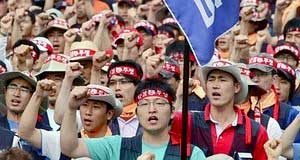Korean workers show the way
Auto plant occupation enters third month
By
Martha Grevatt
Published Jul 24, 2009 7:19 PM
SsangYong Motor is not exactly a household name, even among autoworkers here.
Smaller than Hyundai, Kia and GM-Daewoo, this Korean auto firm only produces
vehicles for the domestic market. Members of the United Auto Workers, however,
need to pay close attention to a fierce battle taking place at a SsangYong
plant in Pyeongtaek, South Korea.
In February SsangYong—in which the privately owned Shanghai Automobile
Industry Corporation holds a 51 percent stake—declared bankruptcy. The
courts approved a restructuring plan that put up the Pyeongtaek plant as
collateral so SsangYong could obtain new financing and come out of bankruptcy
quickly. The backing of the court was contingent, however, on SsangYong
imposing layoffs and involuntary retirements on 1,700 out of 7,000 employees
and immediately discharging 300 “casual” workers. This is on top of
the 1,700 jobs cut since the SAIC takeover three years ago.
|
Thousands
of workers,
members of
the
Korean
Federation
of Trade
Unions, rally
in
Seoul July
4 in support
of SsangYong
workers.
|
At first the situation bore a remarkable similarity to GM and Chrysler’s
restructuring-by-bankruptcy, but on May 27 the Korean Metal Workers Union took
the struggle in a very different direction. The KMWU members did not choose the
path of concessions and retreat. After a series of sporadic strikes beginning
in April, the 1,700 workers who were going to be laid off occupied the plant,
bringing vehicle production to a standstill.
The workers raised three main demands: no layoffs, job security for all and no
outsourcing. For the first few weeks they faced little in the way of a
counterattack. The rightist government of Lee Myong Bak was distracted by his
own political crisis and mass anti-government demonstrations of up to a million
people.
|
Striking workers occupy
auto plant.
|
On June 16 the company held an anti-strike demonstration of about 1,500 scabs,
all but a few hundred of whom were supervisors. Despite the workers’
occupation, the scabs had been inside maintaining machinery but had been unable
to restart production. Around 750 workers from nearby plants, including the Kia
works, came out for a pro-strike counterdemonstration called by mass text
messaging by KMWU.
Knowing that eventually the company and the state would try to evict them, the
occupiers began stockpiling pipes, crow bars and Molotov cocktails. On June 26
the anticipated attack came as riot police, scabs and hired thugs entered the
plant. In accordance with a prearranged plan, workers retreated to the paint
shop. They knew the company would not risk the property damage that would ensue
if the highly flammable chemicals were ignited in that area.
The next day the invaders retreated, the official reason being that enough
violence had occurred.
In an effort to gain public sympathy, SsangYong management sent aerial photos
to the news media taken July 1 as leaflets were distributed urging the strikers
to evacuate. Photos showed no workers leaving, but did show piles of tires on
the roof, apparently intended to be hurled to the ground and set ablaze if
police stormed the plant. Alongside the tires were boxes of bolts allegedly to
be fired by slingshot.
On July 11 the police surrounded the plant, with 100 cops at each of four
gates. Police took control of much of the plant as workers again regrouped in
the paint shop.
On July 16 the KMWU held a solidarity rally of 3,000 outside the Pyeongtaek
City Hall. When the protesters attempted to march on the plant, they were
blocked by police. The cops arrested 82 marchers.
As of July 19 there were still 1,000 courageous workers inside the plant. Their
families continue to keep them well fed. There is a high level of organization,
with about 60 different squads that each elected a delegate to the coordinating
body of the strike.
This occupation takes place in the context of a general upsurge in the class
struggle in U.S-occupied South Korea, but it is the first action of this kind
in Korea in quite some time. It follows recent sit-downs in Chicago, Canada and
Ireland.
The Korean autoworkers are fighting a hard fight and need the support of
workers all over the world. Messages of solidarity can be emailed to the KMWU
at [email protected].
Articles copyright 1995-2012 Workers World.
Verbatim copying and distribution of this entire article is permitted in any medium without royalty provided this notice is preserved.
Workers World, 55 W. 17 St., NY, NY 10011
Email:
[email protected]
Subscribe
[email protected]
Support independent news
DONATE


